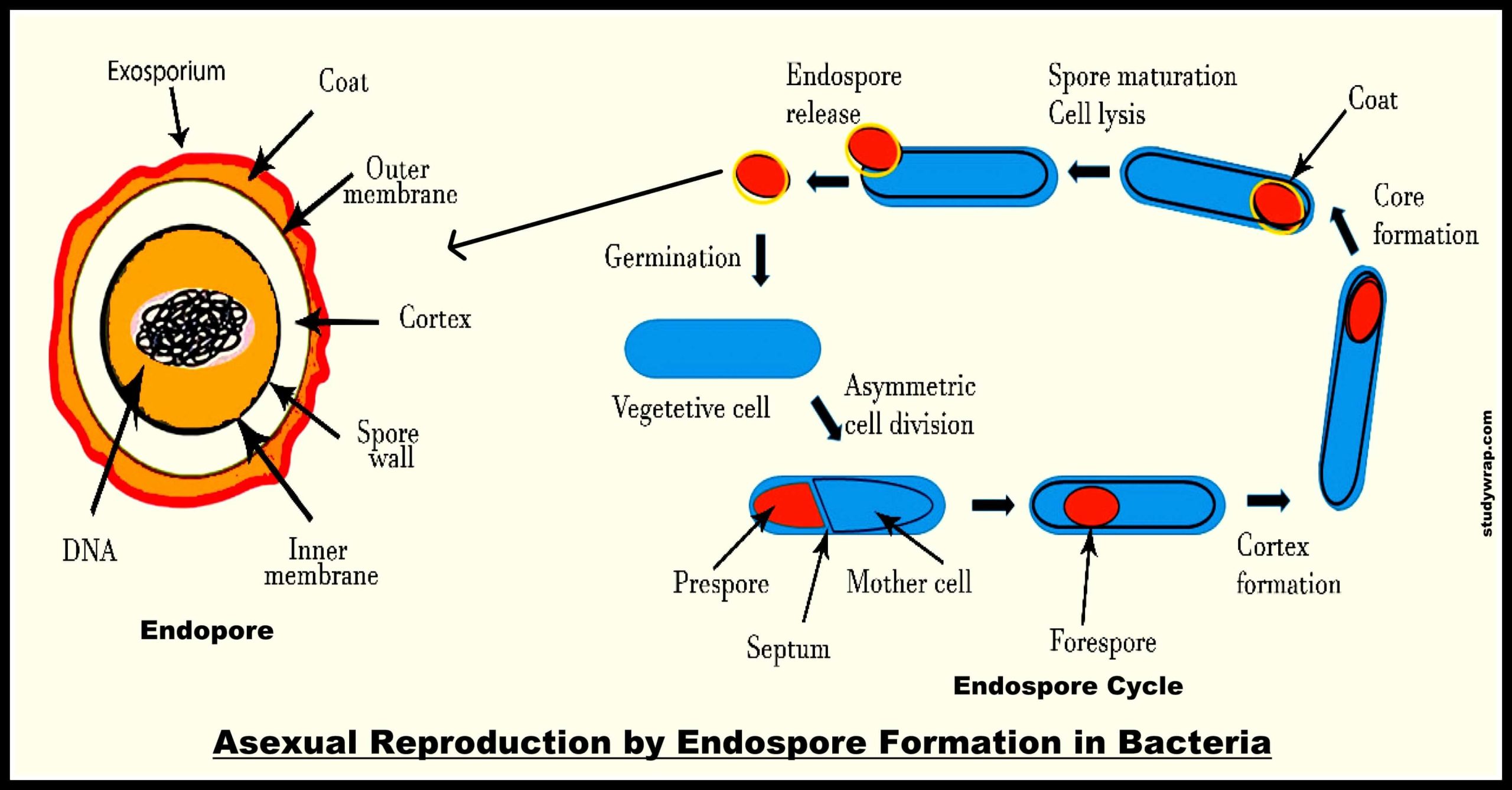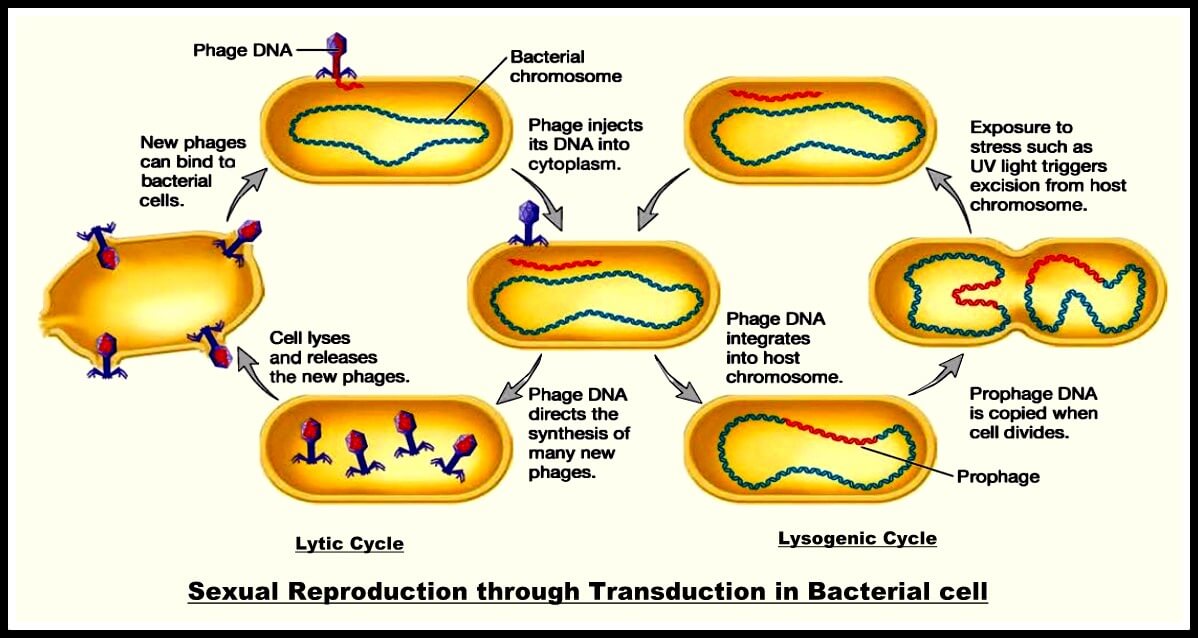Reproduction in Bacteria – Asexual & Sexual Modes
Mode of Reproduction in Bacteria
Table of Contents
· Bacteria are the simple, tiny, and the most effective life form on earth. They were first discovered by Anton Leeuwenhoek (1676). In the five kingdom classification, they are placed in Kingdom Monera.
· Three types of reproduction are known in bacteria. These are –
§ Vegetative reproduction,
§ Asexual reproduction and
§ Sexual reproduction.
Vegetative Reproduction in Bacteria
· It is of following types –
Budding
· In this type of reproduction, a small protuberance called bud, develops at one end of the cell. Genetic material replication follows, and one copy of the Genetic material gets into the bud.
· Then the bud grows, finally become a daughter cell and gets detached from the parent cell.
· It is a rare method of reproduction and is reported in Bigidi bacterium-bifidus.
Binary Fission
· It is the most common type of reproduction in bacteria during favourable conditions. It is similar to amitosis. Here bacterial cell divides into two by constriction in centre. At the same time nuclear material elongates and divides into two equal halves probably helped by mesosome.
· In this process, the cytoplasm and the nucleoid divide equally into two without mitosis, and the two daughter cells formed are identical to each other; hence the name binary fission.
· The whole process of binary fission involves two steps — Genome replication and Septum formation. Both the events occur simultaneously and are triggered by a mesosome.
· A new mesosome develops and gets attached to the daughter chromosome. Membrane grows between the two mesosome to push the daughter nuclear bodies or chromosomes to the opposite side.
· The cytoplasm now undergoes a transverse centripetal constriction in the middle to form two daughter protoplasts, each having a nuclear body.
Asexual Reproduction in Bacteria
· Bacteria reproduce with the help of several types of asexual spores such as sporangiospores, conidia and endospores etc. The most common mode of asexual reproduction is binary fission.
· It occurs by following means –
Endospore Formation
-
-
- During unfavourable condition, highly resistant single spore is formed inside the bacterial cell, which is known as Endospore. It is more common in rod-shaped bacteria or bacillus forms.
- Endospores are formed under conditions of nutrient deficiency, unfavourable temperature, presence of toxic substances, etc.
- Endospore is highly resistant to very high and very low temperature, strong chemicals and acids, etc., thick, resistant and impermeable covering, lower rate of metabolism, due to calcium content, dipicolinic acid and peptidoglycan in cortex etc.
- When favourable conditions come, outer layers rupture and active bacterial cell comes out. So it is a method of perennation (i.e., to tide over unfavourable condition) also and some people say it “reproduction without multiplication”.
-
Conidia Formation
· The formation of conidia takes place in filamentous bacteria such as Streptomyces through the formation of a transverse septum at the apex of the filament.
· The part bearing the conidia is called the conidiophore and after it is detached from the mother cell, in a suitable environment, it germinates giving rise to new cell. This type of asexual reproduction is also called fragmentation.
Zoospores
· In this case, the bacterial cell produces a number of flagellated daughter cells within. These daughter cells are also called as swarmer. The cell wall of parent cell ruptures, releasing gonidia or zoospores. Motile spores are formed in Rhizobium bacteria, but are rare in other bacteria.
Sexual Reproduction in Bacteria
· The bacteria exhibit a primitive form a sexual reproduction which differs from eukaryotic sexual reproduction because there is no gamete formation and fusion. However, the essential feature of sexual reproduction, i.e., exchange of genetic material does take place and is called genetic recombination.
· There are 3 main methods of genetic recombination –
§ Transformation
§ Transduction
§ Conjugation
Transformation
· This was first studied by Griffith (1928) in Diplococcus pneumoniae and hence is known as Griffith effect. Later on it was studied in detail by Avery, McCarty and Mcleod.
· Here genetic material of one bacterial cell goes into another bacterial cell by some unknown mechanism and it converts one type of bacterium into another type (Non-capsulated to capsulated form).
Transduction
· In this method, genetic material of one bacterial cell goes to other bacterial cell through bacteriophages or phages (viruses infecting bacteria).
· Transduction was first of all reported in Salmonella typhimeurium by Zinder and Lederberg (1952).
· The process also occurs in E.coli and a number of other hosts. A virus may pick up gene of the host in place of its own gene during its multiplication in the host cell. Such a virus is never virulent. It passes over the gene of the previous host to the new host.
· Transducing viruses may carry the same genes (restricted transduction) or different genes (generalised transduction) at different times.
Conjugation
· Conjugation was first reported by Lederberg and Tatum (1946) in E. coli bacteria.
· Here cell to cell union occurs between two bacterial cells and genetic material (DNA) of one bacterial cell goes to another cell lengthwise through conjugation tube which is formed by sex pili.
· Conjugation occurs between donor cell and recipient cell. Donor cell is having sex pili and F – factor whereas recipient cell is lacking both.
· The male or donor cell possesses 1 to 4 sex pili on the surface (protoplasmic outgrowths) and fertility factor (F – factor) in its plasmid. The sex pili and fertility factor are absent from the female or recipient cells.
· If these two types of cells happen to come nearer, a pilus of a male cell establishes a protoplasmic bridge or conjugation tube with the female cell. It takes 6-8 minutes for the process to complete.
· In donor cell, F-factor may unite with main genome or nuclear DNA and this donor cell is called Hfr-donor cell (High Frequency donor cell) and here transfer of DNA is rapid. It results in expression of new phenotype in recombinant cell.
So, this was all about the Mode of Reproduction in Bacteria – Vegetative, Asexual and Sexual. If you want to read more notes of Biology Click Here. In the Next Post (Click Here) we will learn about the Difference between Gram Positive and Gram Negative Bacteria.
If you liked our notes, Please subscribe to our newsletter and follow us on Facebook to get regular updates.






